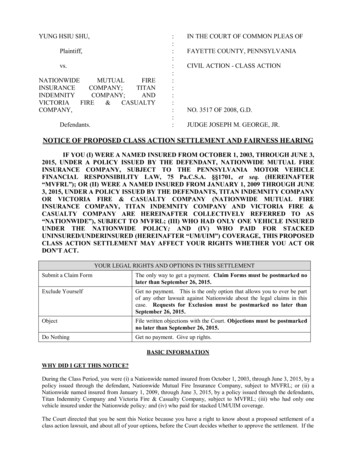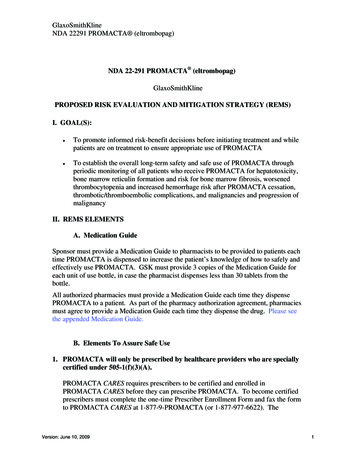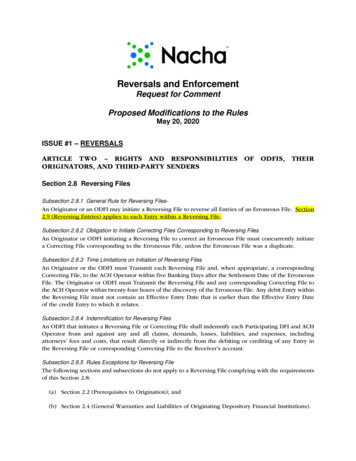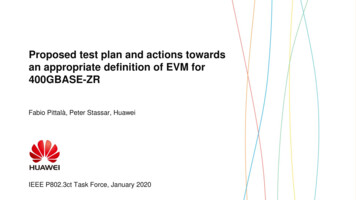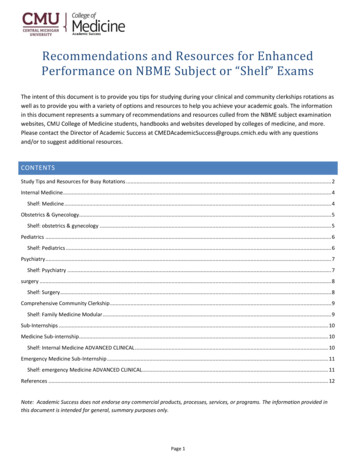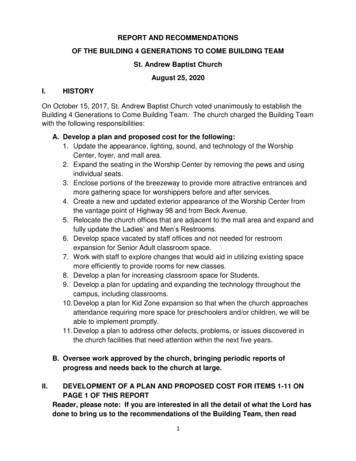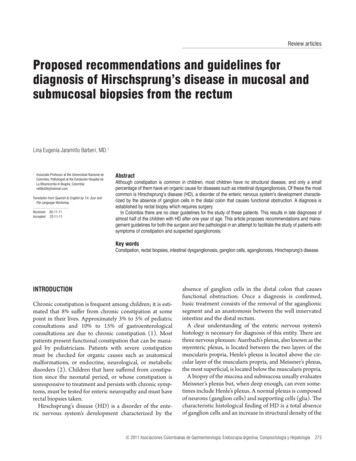
Transcription
Review articlesProposed recommendations and guidelines fordiagnosis of Hirschsprung’s disease in mucosal andsubmucosal biopsies from the rectumLina Eugenia Jaramillo Barberi, MD.11Associate Professor at the Universidad Nacional deColombia, Pathologist at the Fundación Hospital deLa Misericordia in Bogotá, Colombiamillito59@hotmail.comTranslation from Spanish to English by T.A. Zuur andThe Language Workshop.Received: 02-11-11Accepted: 22-11-11AbstractAlthough constipation is common in children, most children have no structural disease, and only a smallpercentage of them have an organic cause for diseases such as intestinal dysganglionosis. Of these the mostcommon is Hirschsprung’s disease (HD), a disorder of the enteric nervous system’s development characterized by the absence of ganglion cells in the distal colon that causes functional obstruction. A diagnosis isestablished by rectal biopsy which requires surgery.In Colombia there are no clear guidelines for the study of these patients. This results in late diagnoses ofalmost half of the children with HD after one year of age. This article proposes recommendations and management guidelines for both the surgeon and the pathologist in an attempt to facilitate the study of patients withsymptoms of constipation and suspected aganglionosis.Key wordsConstipation, rectal biopsies, intestinal dysganglionosis, ganglion cells, aganglionosis, Hirschsprung’s disease.INTRODUCTIONChronic constipation is frequent among children; it is estimated that 8% suffer from chronic constipation at somepoint in their lives. Approximately 3% to 5% of pediatricconsultations and 10% to 15% of gastroenterologicalconsultations are due to chronic constipation (1). Mostpatients present functional constipation that can be managed by pediatricians. Patients with severe constipationmust be checked for organic causes such as anatomicalmalformations, or endocrine, neurological, or metabolicdisorders (2). Children that have suffered from constipation since the neonatal period, or whose constipation isunresponsive to treatment and persists with chronic symptoms, must be tested for enteric neuropathy and must haverectal biopsies taken.Hirschsprung’s disease (HD) is a disorder of the enteric nervous system’s development characterized by theabsence of ganglion cells in the distal colon that causesfunctional obstruction. Once a diagnosis is confirmed,basic treatment consists of the removal of the aganglionicsegment and an anastomosis between the well innervatedintestine and the distal rectum.A clear understanding of the enteric nervous system’shistology is necessary for diagnosis of this entity. There arethree nervous plexuses: Auerbach’s plexus, also known as themyenteric plexus, is located between the two layers of themuscularis propria, Henle’s plexus is located above the circular layer of the muscularis propria, and Meissner’s plexus,the most superficial, is located below the muscularis propria.A biopsy of the mucosa and submucosa usually evaluatesMeissner’s plexus but, when deep enough, can even sometimes include Henle’s plexus. A normal plexus is composedof neurons (ganglion cells) and supporting cells (glia). Thecharacteristic histological finding of HD is a total absenceof ganglion cells and an increase in structural density of the 2011 Asociaciones Colombianas de Gastroenterología, Endoscopia digestiva, Coloproctología y Hepatología273
plexuses. Glial cells are replaced by Schwann cells, hypertrophy is present, and nerves look similar to peripheralnerves (3).Diagnosis of HD continues to be a problem in thiscountry because a large proportion of pathologists areuncomfortable doing this study because of the difficultyof evaluating material submitted by the surgeon. This isdue to the absence of any guidelines to guarantee goodperformance of the biopsy. This report details some recommendations based on my experience of over 20 years in apediatric hospital that has become a referral institution forthis type of study.From 2005 to 2009 we conducted 272 studies of childrensuspected of having HD: 106 were patients in our institution, and 166 were referrals for diagnosis or a second opinion. Most biopsies were from the mucosa and submucosa.The average level of biopsies per patient was 3.13 (2.3 to 5).During this period 56 patients were diagnosed with HD,equivalent to 20.58% (4). This is a high incidence compared to those reported in the literature (5). The most likelyexplanation for this is that our referral institution receivesmore cases than are in the general population. There were44 boys and 12 girls with a ratio of 3.66: 1 which is similarto that described in the literature (5).Publications of studies in industrialized countriesreport that more than two thirds of HD patients are diagnosed during the neonatal period and almost 95% beforeone year of age (5, 6). In our cases we found that, of the 56patients diagnosed with HD, 44.64% were older than oneyear, 33.92% were between 1 and 11 months, and only14.28% were neonates (7). The remaining 7.16% had noreference age listed. This reflects a problem in our diagnostic opportunity which is probably a mix of factors suchas lack of consensus on the management of constipationby doctors, lack of criteria for rectal biopsies, and misleading or inaccurate reports obtained from the histopathological studies.Our high volume of extra-institutional cases (61.03%)highlights a lack of confidence on the part of pediatric surgeons and general pathologists to undertake the study ofpatients with constipation. This in turn raises the need todevelop a protocol for management of rectal biopsy material which would ensure proper orientation and emphasizethe obligation of conducting broad and standardized seriesof pathology reports. For these reasons the objective of thisreview is to share my experience and make recommendations to facilitate the diagnosis of Hirschsprung’s disease.STEP BY STEPOne of the biggest responsibilities that we have when weconduct studies of rectal biopsies taken because of consti274Rev Col Gastroenterol / 26 (4) 2011pation is to guarantee that the material has been removed,cut, handled and fixed in the correct ways so that the probability of making a correct diagnosis is increased. To this end,there are tasks which are the responsibility of the surgeon,and others which are the responsibility of the pathologist.The surgeon should obtain an adequate number of rectalbiopsies which should all be of adequate size and depth. Thesurgeon should place them in a 10% formaldehyde solution.We recommend taking biopsies at three or more levels. Eachbiopsy should be properly marked to indicate at how manycentimeters from the pectinate line it was taken.The pathologist should Orient and cut the specimens, and then request thatthe technician test a series of between 50 and 100 cutsstained with hematoxylin and eosin. Evaluate the histological material and decide whetheror not it is adequate. If its is not, the pathologist shouldreport this. The pathologist should clearly understand the classicsigns of HD. The pathologist should perform a differential diagnosiswhen appropriate.None of the hospitals in this country use the histochemicalstaining technique for the acetylcholine esterase enzyme(AChE) as a marker for nerve fibers of the lamina propriaand muscularis mucosa, even though this is considered bymany to be the most important diagnostic tool for HD (8).Many institutions use only routine techniques, althoughincreasing numbers of laboratories have access to the useof immunohistochemical markers that can occasionally bevery useful even though in most cases they are not essentialfor diagnosis.The key to the success of the study is to begin as soonas the sample is taken. In our institution we do not havesuction biopsy equipment, so the material is obtained bytransrectal biopsy conducted in operating rooms undergeneral anesthesia. The patient is placed in a prone position, the rectum is dilated with a rectal speculum to exposeits anterior wall, the biopsy level is chosen, a suture is stitched just below the mucosa, submucosa is pulled up, andthe fragment is cut with scissors (Figure 1). The numberof levels from which biopsies were taken varies in differentschools. A little over a year ago, the surgeons in our institution by consensus to take biopsies from levels 3 and 5 levelsat distances of 1,2,3,4 and 5 cm from the pectinate line.The biopsy size generally ranges from 0.3 to 0.5 cm whichis sufficient if the sample is carefully handled. Our pathology service recommends that the surgeon avoid areas ofthe mucosa which look like they contain micronodules, asReview articles
these samples are generally lymphoid aggregates occupyingthe submucosa and displacing Meissner’s plexus.Figure 1. Taking the biopsy, identification and orientation of sample forcross sections.Unlike routine biopsies in which the pathologist’s dutiesare limited to counting the fragments received, measuringthem, and putting them into the processing cassettes, testing of biopsies taken for diagnosis of HD should be guided by a specialist. For these cases the layer necessary fordiagnosis is the submucosa, so that guaranteeing that thistissue is well represented is vital. I recommend placing thefragment on a piece of paper with the mucosa side down.Then, stretch the tissue carefully so as not to crush it, andmake as many parallel cuts as possible along the minor axiswith distance between each cut of approximately 0.10 cm(Figure 2 and 3). The purpose of this procedure is to avoidto the extent possible oblique inclusions which containvery little of the submucosa, and to avoid samples of onlythe “head” which in which the observable tissue is eitherrectal mucosa or muscularis mucosa (Figure 4).Figure 3. Anterior view of specimen after cross sections.Figure 4. Material unsuitable for study of innervation because there isno submucosa to evaluate.Figure 2. 0.5 cm endorectal biopsy including mucosa and submucosa.In our service technicians have already been shownFigures 2 and 3 and have been taught that for these samples, unlike other gastrointestinal tract biopsies, the keypart to study is the submucosa. Given that the technicianProposed recommendations and guidelines for diagnosis of Hirschsprung’s disease in mucosal and submucosal biopsies from the rectum 275
has already received guidance on the type of samples to betested, we send the material order “For Innervation.” Thismeans cutting each block into two or three layers withan average of 12 to 15 slices cut from each of these layers(Figure 5). This result is between 60 and 120 slides perbiopsy. It is important to order the series from the start toensure that tissue is not wasted in mounting and remounting the slices. In most cases this is sufficient to diagnose orrule out aganglionosis. At the same time, usually is a smallremnant of tissue in the block which can be used to add tothe series in problematic cases or which can be tested withsupplementary immunohistochemistry.Figure 5. Perform examination of each level of transrectal biopsy sentfor study.It is important that a pathologist who is not an expert inHD to have clear concepts about the classic indications ofthis disease. You can not confuse, “I see no ganglion cells,”with, “There are no ganglion cells.” Since this is a disease thediagnosis of which is based on the absence of an elementof histology, it is essential that the pathologist is sure that,both in terms of technology and knowledge, everythingis consistent with aganglionosis. In general terms classicalHD, i.e. short segment HD which occurs in 75% to 80%of cases, involves the distal sigmoid colon and rectum andis characterized histologically by nerve filaments which arelarge, thick, and compact. Nerve filaments are generally larger than 40 microns in diameter, and there are definitely no276Rev Col Gastroenterol / 26 (4) 2011ganglion cells in these cases. If the filaments are few, small orlax, and do not look like neurons, it is valid to question thediagnosis and to suspect other diseases (3, 9). It is important to remember that long segment aganglionosis, especially total colonic aganglionosis, contrary to usual there canbe decreased or nearly absent plexus. In these cases, as inalmost all pathological studies, history and correlation areessential to guide the pathologist.It is also vitally important to determine when a biopsyis insufficient or inadequate for diagnosis. Anatomically,the lower level of sampling is should be one or ideally 2cms above the pectinate line. Biopsies which are very lowor close to the anal sphincter may not have ganglion cellseven when the patient does not have aganglionosis. Whenganglion cells are not observed in a biopsy and there areislands of squamous epithelium or sphincter muscle fibers,it is the unequivocal signature that the sample was obtained from below the pectinate line. This should always bereported as a sample which is inadequate for diagnosis. If indoubt about the sampling site, I recommend making a noteto remind the clinician and avoid misinterpretations. Fromthe histological point of view a rectal biopsy is consideredappropriate when the amounts of mucosa and muscularismucosa together are equivalent in thickness to the amountof submucosa (Figure 6) (10). If the amount of submucosain the sample is good, but it contains a lymphoid follicle,this must also be considered unsuitable for making a HDdiagnosis (Figure 7). For any type of sample received, thepathologist should look judiciously at all cuts. Sometimesneurons can be identified in the periphery of the follicle, orimmersed in the muscularis mucosa, in which cases aganglionosis can certainly be ruled out even when biopsiesseemed inappropriate for the study (Figure 8).The easiest diagnosis to establish in biopsies of rectalmucosa-submucosa is that normal innervation is present.In fact, this is the most often seen case, and i
Hirschsprung’s disease (HD) is a disorder of the ente-ric nervous system’s development characterized by the absence of ganglion cells in the distal colon that causes functional obstruction. Once a diagnosis is confi rmed, basic treatment consists of the removal of the aganglionic segment and an anastomosis between the well innervated
